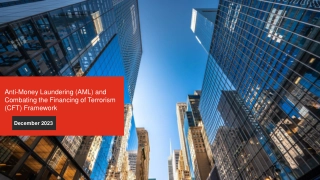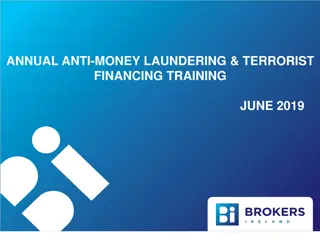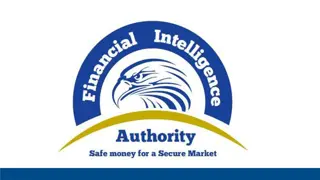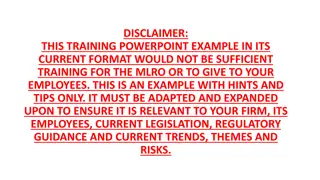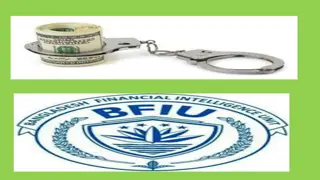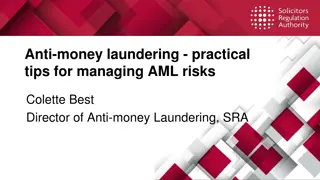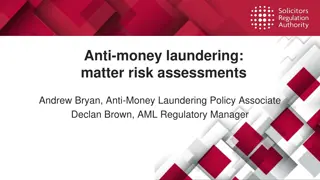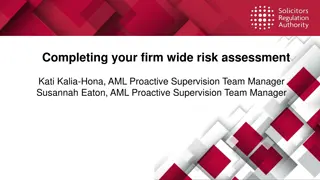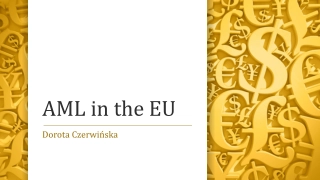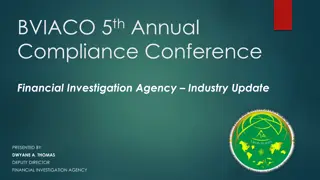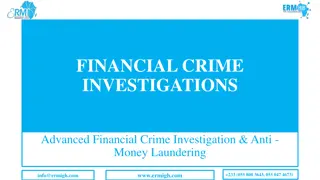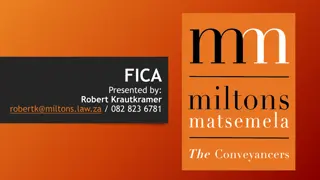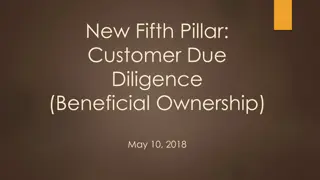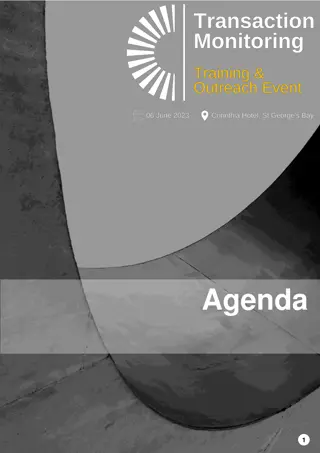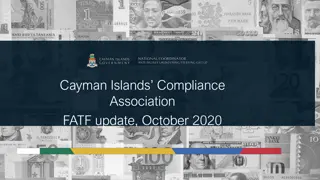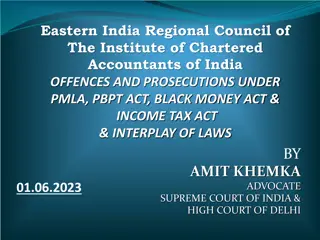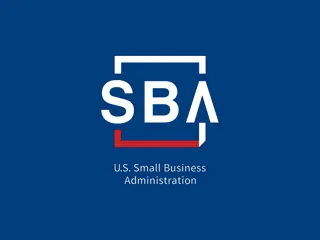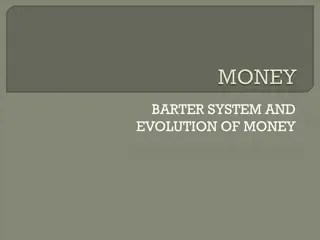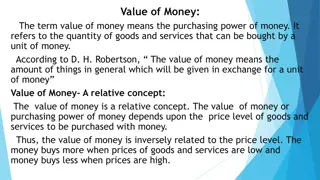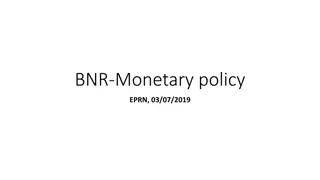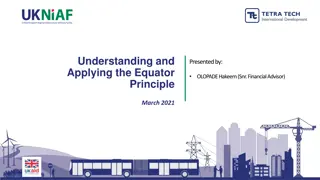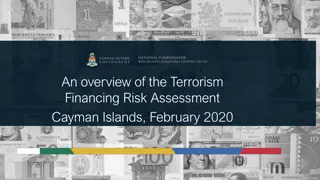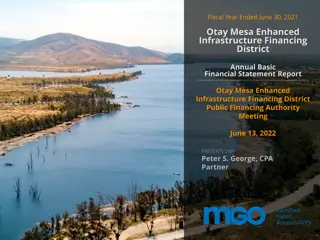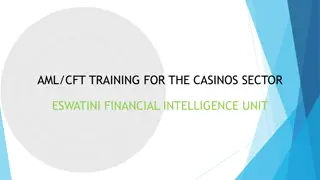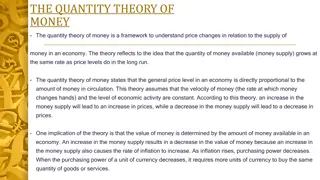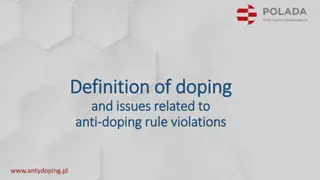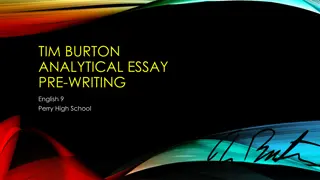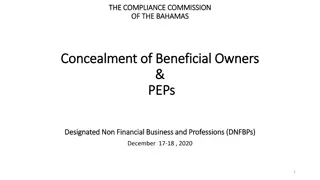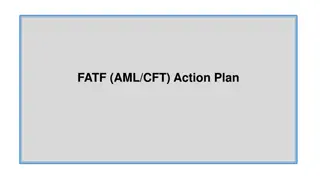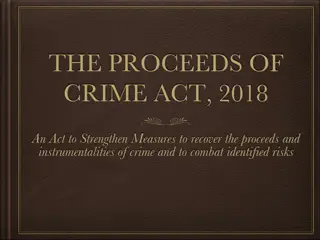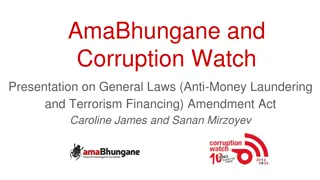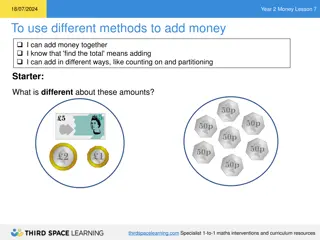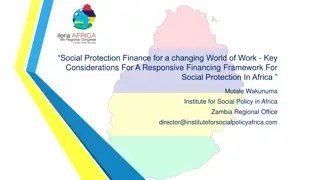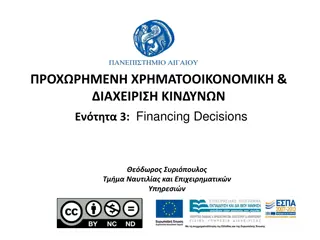Understanding Anti-Money Laundering & Terrorist Financing Training
Explore the essential aspects of anti-money laundering (AML) and terrorist financing, including the Irish legislative framework, definitions, and stages of money laundering. Learn about designated persons, key legislation, and the consequences of engaging in illegal financial activities.
Download Presentation

Please find below an Image/Link to download the presentation.
The content on the website is provided AS IS for your information and personal use only. It may not be sold, licensed, or shared on other websites without obtaining consent from the author. Download presentation by click this link. If you encounter any issues during the download, it is possible that the publisher has removed the file from their server.
E N D
Presentation Transcript
ANNUAL ANTI-MONEY LAUNDERING & TERRORIST FINANCING TRAINING MAY 2022
Important Members should note this is a template presentation and must be personalised by the firm to reflect their own policies and procedures.
Legislation The Irish AML/CTF legislative framework is set out in the Criminal Justice (Money Laundering and Terrorist Financing) Act 2010, the Criminal Justice (Money Laundering and Terrorist Financing) (Amendment) Act 2018 and the Criminal Justice (Money Laundering and Terrorist Financing) (Amendment) Act 2021. The key changes in the 2021 Act include: Creation of new categories of Designated Person; the expansion of the PEP definition; new triggers for conducting customer due diligence and the inclusion of a list of enhanced due diligence measures to be taken when dealing with customers residing or established in high risk third countries.
What is Anti-Money Laundering & Terrorist financing? It is the process by which criminals conceal the true origin and ownership of the proceeds of drug trafficking or other criminal activity. A common misconception in relation to Money Laundering is that it only relates to theft, drug or similar offences. It might also be: Tax evasion Financial fraud and deception Theft
To be guilty of money laundering a person must know or believe the property involved is or probably is the proceeds of criminal conduct or be reckless as to whether the property is the proceeds of criminal conduct. Terrorist Financing Funds intended to finance an act of terrorism. Links between terrorist groups and organised criminal gangs. Includes converting, transferring, handling, acquiring, possessing or using the property that is the proceeds of criminal conduct. There must be intention or knowledge in providing or collecting funds for the purposes of financing terrorism, in order for there to be an offence. 5
Stages of Money Laundering There are three stages in the money laundering process: Placement this is the physical disposal of cash; Layering the creation of complex layers which make tracking transactions difficult; Integration absorbing the money back into the economy as legitimate money. 6
Designated Persons Mortgage Intermediaries and intermediaries by virtue of their registration as Insurance Intermediaries who provide Life Assurance or other investment related services are deemed to be DesignatedPersons . Note: Intermediaries only operating in the General Insurance market are not subject to the AML legislation. However they are expected to be mindful of other legislation that would apply such as Financial Sanctions and to have controls and procedures in place to detect and prevent financial crime, and as a result, to report suspicious transactions. Staff would need to be trained in this regard. (See Appendix 6 in Brokers Ireland AML Guidance notes for further information) 7
Designated Persons must have internal policies and procedures to reflect the requirements of the legislation in relation to the following areas: Customer due diligence Reporting Record keeping Internal procedures & training (All staff including executive & non-executive directors are required to receive annual training in relation to AML & combating terrorist financing.) 8
What does Customer Due Diligence mean? Identify & verify the customer. Identify & verify the beneficial owner (An individual who ultimately owns or controls the customer and/or on whose behalf a transaction or activity is conducted). Establish purpose & intended nature of business relationship (a business, professional or commercial relationship between the designated person and the customer that the designated person expects to be ongoing). Monitor customer dealings on an on-going basis.
Beneficial Owner An Individual holding 25% or more of shares or voting rights. Company Partnership An Individual holding 25% or more of profits or capital or voting rights, Trusts An individual who is entitled to a vested interest in the trust property may be considered a beneficial owner. Additionally, settlors, trustees and protectors of a trust may now also be considered beneficial owners. The threshold of 25% ownership no longer applies. Estate Executor.
Beneficial Owner Where the beneficial owner identified is the senior managing official, firms are required to take the necessary reasonable measures to verify the identity of the natural person who holds the position of senior managing official and shall keep records of the actions taken as well as any difficulties encountered during the verification process. A designated person is obliged by virtue of any enactment or rule of law, including the European Union (Administrative Cooperation in the Field of Taxation) Regulations 2012 (S.I. No. 549 of 2012), to contact a customer for the purposes of reviewing any relevant information relating to the beneficial owner connected with the customer.
Beneficial Owner Cross-checking Prior to the establishment of a business relationship with a customer to which the European Union (Anti-Money Laundering: Beneficial Ownership of Corporate Entities) Regulations 2019 (S.I. No. 110 of 2019) (modified by the European Union (Modifications of Statutory Instrument No. 110 of 2019) (Registration of Beneficial Ownership of Certain Financial Vehicles Regulations 2020) (S.I. No. 233 of 2020) apply: a designated person shall ascertain that information concerning the beneficial ownership of the customer is entered in the Central Register of Beneficial Ownership of Companies and Industrial Provident Societies or, as the case may be, the Central Register of Beneficial Ownership of Irish Collective Asset-management Vehicles, Credit Unions and Unit Trusts.
Beneficial Owner Cross-checking Firms should establish whether their customer has in fact exhausted all possible means to identify their beneficial owner(s). The Firm shall ensure that no transactions in connection with the account are carried out on behalf of the customer or beneficial owner until it is established that the beneficial ownership information is entered into the relevant beneficial ownership register.
Beneficial Owner requirements Firms should: Compile documented assessments determining scenarios where beneficial ownership may be a factor with regard to the provision of products and services offered by the Firm; and Assess and document: the degree of verification required regarding the beneficial owners depending on the associated ML/TF risk attaching to such beneficial owners; the procedures to be applied in these circumstances; and where relevant, measures taken to identify a beneficial owner and any difficulties encountered in establishing a beneficial owner s identity.
Beneficial Owner requirements contd. Prior to the establishment of a business relationship, Firms are required to confirm that information concerning the beneficial ownership of a customer is entered in the following registers, where applicable: The express trust (beneficial ownership) register (in accordance with Section 35(3A) of the CJA 2010; The Central Register of Beneficial Ownership of Companies and Industrial Provident Societies or, as the case may be, The Central Register of Beneficial Ownership of Irish Collective Asset management Vehicles, Credit Unions and Unit Trusts (in accordance with Section 35(3C) of the CJA 2010.
Purpose & intended nature of the business relationship In most cases this will be self evident e.g. Investing in a life policy Opening bank account Ongoing monitoring Scrutinise transactions: Source of wealth or funds Consistent with knowledge of customer and the customer s business and pattern of transactions
Customer Due Diligence Requirements Legislation allows designated persons to apply aspects of the customer due diligence requirements on a risk-sensitive basis depending on: a) The nature of the product being sold; b)The delivery mechanism or distribution channel used to sell the product; c) The profile of the customer; and d)The customer s geographical location and source of funds.
Intermediaries are required to carry out Customer Due Diligence Prior to establishing a business relationship with the customer; Prior to carrying out an occasional transaction or service for a customer; Prior to carrying out any service for a customer, if, having regard to the circumstances, the firm has reasonable grounds to suspect that the customer is involved in, or the service, transaction or product sought by the customer is for the purpose of ML/TF;
Intermediaries are required to carry out Customer Due Diligence (contd.) Prior to carrying out any service for a customer where the firm has reasonable grounds to doubt the veracity or adequacy of documents; At any time, including where the relevant circumstances of a customer have changed; At any time where a Firm is obliged by virtue of any enactment or rule of law to contact a customer for the purposes of reviewing any relevant information relating to the beneficial owner connected with the customer. A client risk assessment form is recommended to be completed to assess the risk per transaction See Appendix 3 BI Guidance notes
Risk-based approach In applying a risk-based approach to their AML/CFT obligation, Firms should be cognisant of the importance and benefits of financial inclusion. A zerotolerance approach, or wholesale termination of business relationships with entire categories of customers, without an individual assessment and consideration of the risk posed, and due consideration of the measures that could mitigate such risks, is not consistent with the risk-based approach.
Risk-based approach (contd.) A Firm should not take a decision to terminate a business relationship with an individual customer, or cease to provide a particular financial product or service to a customer, unless the Firm has fully considered whether it could apply any additional enhanced measures to reduce the ML/TF risk in the continuation of the business relationship, or the provision of a particular financial product or service. Following the exploration of any additional enhanced measures which a Firm may consider putting in place in order to reduce the ML/TF risk, if a Firm decides that they cannot sufficiently reduce the ML/TF risk posed to an acceptable level, the Firm should document fully its rationale for a decision to terminate a business relationship or to cease the provision of a particular product or service.
Risk-based approach (contd.) This decision should include an analysis of the ML/TF risks presented, the additional measures it considered putting in place to mitigate such risks, and the reasons they were deemed insufficient, so that such decision can be reasonably justified.
Three categories of Customer Due Diligence (CDD) Simplified Customer Due Diligence applies where the customer or business area is considered to be low risk. Enhanced Due Diligence now applies to high risk third countries, higher risk relationship/transactions and resident and non-resident Politically Exposed Persons deemed to be high risk. Standard Due Diligence must be applied to all remaining customers and products.
Simplified Customer Due Diligence Designated persons will be allowed to carry out Simplified Customer Due Diligence where the customer or business area is considered to be low risk. Simplified Customer Due Diligence can only be applied where a designated person has identified in its business risk assessment, an area of lower risk into which the relationship or transaction falls, and the relationship or transaction concerned can reasonably be considered to be low risk. Please see Appendix 4 and Appendix 5 in BI AML Guidance notes for a list of factors suggesting potentially lower and higher risk.
Simplified Customer Due Diligence contd. Where a firm has applied Simplified Customer Due Diligence, it is required to: Retain record of the reasons for its determination and evidence upon which is was based; and Carry out sufficient monitoring of the transactions and business relationships to enable the firm to detect unusual or suspicious transactions.
Simplified Customer Due Diligence contd. Examples of products which may fall into the simplified customer due diligence category are: Protection policies with annual premium of less than 1000 Pension business (except ARF and AMRF) Note: Intermediaries must at all times take into account the type of customer, countries or geographical areas, transactions and delivery channels and document the rationale for categorising these products as lower risk for the purposes of applying CDD.
Enhanced Due Diligence (EDD) High risk third countries A designated person is required to apply enhanced customer due diligence measures when dealing with a customer established or residing in a high-risk third country.
Enhanced Due Diligence High risk third countries At present there are 23 countries* that have been identified as 'high risk third countries . Please see the link to jurisdictions under increased monitoring: https://www.fatf-gafi.org/publications/high-risk-and-other- monitored-jurisdictions/documents/increased-monitoring-october- 2021.html#:~:text=The%20following%20countries%20had%20their,Se negal%2C%20Uganda%2C%20and%20Zimbabwe. *Please note this list is continuously updated
Enhanced Due Diligence contd. High risk third countries A designated person shall apply the following measures to manage and mitigate the risk of money laundering and terrorist financing when dealing with a customer established or residing in a high-risk third country: (a) obtaining additional information on the customer and on the beneficial owner; (b) obtaining additional information on the intended nature of the business relationship; (c) obtaining information on the source of funds and source of wealth of the customer and of the beneficial owner; (d) obtaining information on the reasons for the intended or performed transactions; (e) obtaining the approval of senior management for establishing or continuing the business relationship; (f) conducting enhanced monitoring of the business relationship by increasing the number and timing of controls applied and selecting patterns of transaction that need further examination.
Enhanced Due Diligence contd. Relationship/transaction presents a higher risk Firms should examine the background and purpose of all transactions that: (a) are complex, (b) are unusually large, (c) are conducted in an unusual pattern, or (d) do not have an apparent economic or lawful purpose.
Enhanced Due Diligence contd. Enhanced due diligence measures apply to PEPs resident in Ireland and non-resident PEPs. A Politically Exposed Person (PEP) is an individual who is or has been entrusted with a prominent public function or are currently performing or have performed a prescribed function (as determined by the Minister for Justice). Examples of PEPs include: Senior official of a major political party Senior official in the executive, legislative, administrative, military, or judicial branch of a government Senior Member of Defence Forces Directors, deputy directors or member of the board/equivalent function for an international organisation Senior executive of a government owned commercial enterprise or corporation. Any individual known to be a personal or professional associate of a PEP An immediate family member of a PEP; e.g. spouse, parents, siblings, children.
Enhanced Due Diligence contd. Firms should note that PEP status itself is intended to apply higher vigilance to certain individuals and put those individuals that are customers or beneficial owners into a higher risk category. It is not intended to suggest that such individuals are involved in suspicious activity. PEPs Additional requirements are imposed regarding the identification of the beneficiaries of life assurance policies and other investment-related assurance policies Life Assurance Policies/PEPs
Enhanced Due Diligence contd. Life Assurance Policies/PEPs Specific steps must be taken where the PEP is a beneficiary of a life assurance policy. If a designated person knows or has reasonable grounds to believe that a beneficiary of a life assurance or other investment-related assurance policy or a beneficial owner of the beneficiary concerned, is a politically exposed person, or an immediate family member or a close associate of a politically exposed person, it shall: a) inform senior management before pay-out of policy proceeds and b) conduct enhanced scrutiny of the business relationship with the policyholder
Enhanced Due Diligence contd. PEP Identification Firms should put appropriate policies and procedures in place to determine: If a customer or beneficiary is a PEP at on boarding; or If a customer becomes a PEP during the course of the business relationship with the firm. Firms should note that new and existing customers may not initially meet the definition of a PEP, but may subsequently become one during the course of a business relationship with the firm.
Enhanced Due Diligence contd. Firms should undertake regular and on-going screening of their customer base and the customers beneficial owners (where relevant), to ensure that they have identified all PEPs. The frequency of PEP screening should be determined by firms commensurate with their business wide risk assessment. Firms policies and procedures should address how any PEP relationship identified will be managed by the firm including: Application of EDD Obtaining Senior Management approval Enhanced on-going monitoring
Enhanced Due Diligence contd. Firms should continue to apply the measures referred to in the previous slide to a politically exposed person for as long as it is reasonably required to take into account the continuing risk posed by that person, and until such time as that person is deemed to pose no further risk specific to politically exposed persons. Each Member State and any international organisation accredited to it will be required to keep an up-to-date list of exact functions which qualify as prominent public functions. A single list of all prominent public functions will be assembled by the Commission and will be made public.
Enhanced Due Diligence contd. Where firms are purchasing politically exposed persons (PEP) lists, they should check how their provider is using the information published to support the production of the PEP list. Firms should also ensure the PEP lists that they maintain are kept up to date.
Enhanced Due Diligence contd. The Firm must allocate responsibility for the approval of PEP relationships, and must ensure that the approval of a PEP relationship is conducted by individuals who are appropriately skilled and empowered, and this process is subject to appropriate oversight. Firms should determine the level of seniority for sign-off by the level of increased ML/TF risk associated with the business relationship.
Standard Customer Due Diligence (SCDD) Applied on a risk based approach Profile of the customer Nature of product or service Distribution channel Geographical area of operation
Standard Customer Due Diligence Factors which indicate lower risk Customer Risk Factors: a) public companies listed on a stock exchange and subject to disclosure requirements (either by stock exchange rules or through law or enforceable means), which impose requirements to ensure adequate transparency of beneficial ownership; b) public administrations or enterprises; c) Customers that are resident in geographical areas of lower risk as set out in subparagraph (3).
Standard Customer Due Diligence Factors which indicate lower risk Product, service, transaction or delivery channel risk factors: a) Life assurance policies for which the premium is low; b) Insurance policies for pension schemes if there is no early surrender option and the policy cannot be used as collateral; c) A pension, superannuation or similar scheme that provides retirement benefits to employees, where contributions are made by way of deduction from wages, and the scheme rules do not permit the assignment of a member s interest under the scheme;
Standard Customer Due Diligence Factors which indicate lower risk Product, service, transaction or delivery channel risk factors contd: (d) financial products or services that provide appropriately defined and limited services to certain types of customers, so as to increase access for financial inclusion purposes; (e) products where the risks of money laundering and terrorist financing are managed by other factors such as purse limits or transparency of ownership (e.g. certain types of electronic money).
Standard Customer Due Diligence Factors which indicate lower risk Geographical risk factors- registration, establishment, residence in : (a) EU Member States; (a) third countries having effective anti-money laundering (AML) or combating financing of terrorism (CFT) systems; (b) Third countries identified by credible sources as having a low level of corruption or other criminal activity;
Standard Customer Due Diligence Factors which indicate lower risk Geographical risk factors- registration, establishment, residence in contd: (a) Third countries which, on the basis of credible sources such as mutual evaluations, detailed assessment reports or published follow-up reports, have requirements to combat money laundering and terrorist financing consistent with the revised Financial Action Task Force (FATF) recommendations and effectively implement these requirements. .
Standard Customer Due Diligence Lower risk There are products due to their inherent features which are unlikely to be used as a vehicle for money laundering purposes. The following features would indicate low risk: Only pays out on death or diagnosis of terminal illness of policy holder. Only pays out on medical evidence and proof is required as to loss of income. No surrender value. Small, regular premiums: additional payments by customer not possible. Large premiums will normally require medical evidence. No investment element. Once term of policy is finished no payout and policy ceases.
Standard Customer Due Diligence Generally, for protection products with annual premium of less than 1000, due diligence requirements are satisfied by the Name, Address and Date of Birth information collected on the application form in conjunction with the fact that the payment is made from an account in the customer s name (i.e. personal cheques and other payment instruments drawn on policy owner s own account such as Direct Debits/Standing Orders) If payment is made by bank draft for the products above Brokers Ireland would recommend that the client is requested to request confirmation from the bank confirming where the money is coming from and request completion of the source of funds form. Appendix 7 BI Guidance
Standard Customer Due Diligence Medium Risk The medium risk level is given to products whose inherent features pose some risk for the purposes of money laundering or terrorist financing. These may be products which have a facility for top up payments. Examples: Life assurance savings plan With premium under 5000 Investment Bonds with premium under 5000 Post Retirement pension products: ARF & AMRFs
Standard Customer Due Diligence Medium Risk Due Diligence requirements: Name, address and date of birth collected on the application form in conjunction with the fact that the payment is made from an account in the policy owner s name (i.e. personal cheques and other payment instruments drawn on policy owner s account such as Direct Debits/Standing Orders) If payment is not by way of Direct Debit/personal cheque drawn on policy owners own account, complete source of funds form (Appendix 7 BI Guidance) Certified copies of identification and proof of address for policy owner and third party if applicable.
Standard Customer Due Diligence Factors which indicate higher risk Customer risk factors: (a) the business relationship is conducted in unusual circumstances; (b) customers that are resident in geographical areas of higher risk as set out in subparagraph (3); (c) non-resident customers; (d) legal persons or arrangements that are personal asset-holding vehicles;
Standard Customer Due Diligence Factors which indicate higher risk Customer risk factors contd: (e) companies that have nominee shareholders or shares in bearer form; (f) businesses that are cash intensive; (g) the ownership structure of the company appears unusual or excessively complex given the nature of the company s business. (h) the customer is a third country national who applies for residence rights or citizenship in the State in exchange for capital transfers, purchase of property or government bonds or investment in corporate entities in the State.


